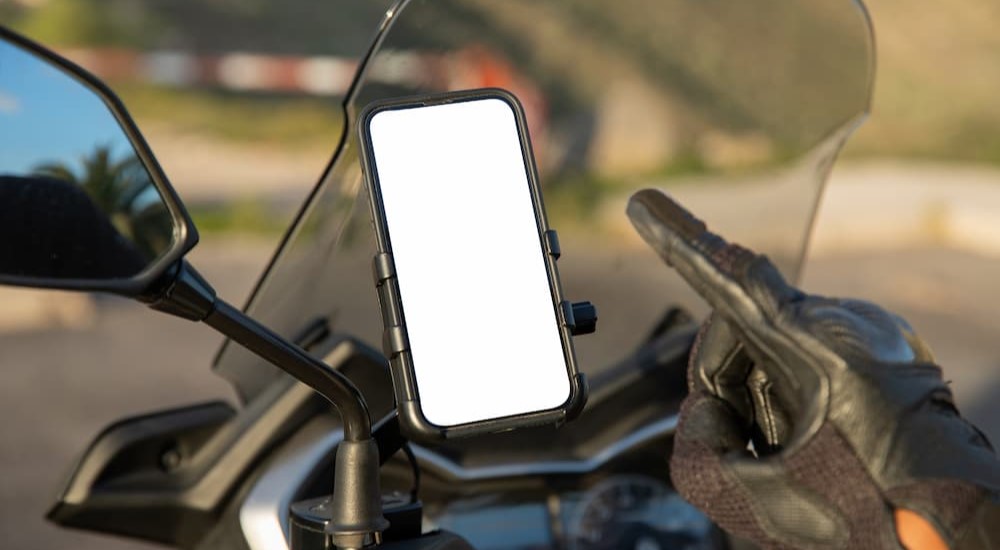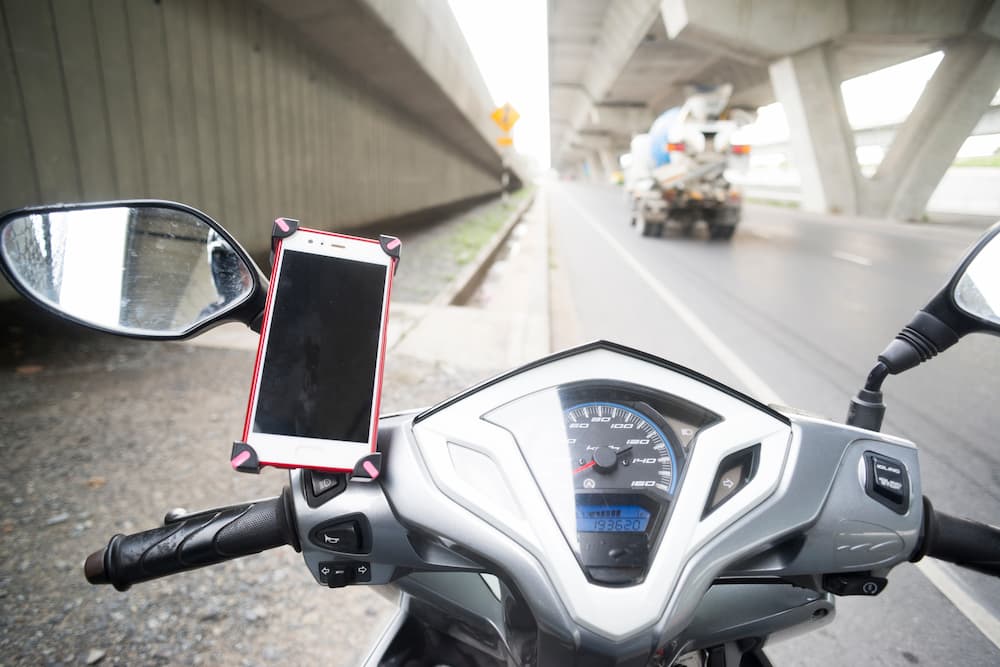Smartphones have become an indispensable part of everyday life on the road, from checking directions to staying in touch with friends and family. Most modern cars have accepted the fact and offer large infotainment centers that use Apple CarPlay, Android Auto, and Bluetooth to mirror your favorite smartphone features in an easy-to-access manner. However, motorcycle riders have a tougher time of it, with the open-air nature of their rides making it especially difficult to access their phones on the go.
Luckily technology is here to help, with motorcycle phone mounts, Bluetooth-connected helmets, and a collection of clever apps making it easier than ever to stay connected while on two wheels. That said, securely isn’t always the easiest task. Between the vibrations, tight cornering, and high speeds, it’s all too easy for a phone to become dislodged and end up skipping across the pavement.
How can a rider ensure their phone’s longevity while still having access to all the news, entertainment, and data they’ve become accustomed to? Read on as we explore some of the dos and don’ts of mounting phones on motorcycles, explore different mount designs, and see how placement can make all the difference when it comes to safely enjoying your next ride.

Where to Place It
The first issue riders are faced with when it comes to mounting phones on motorcycles comes down to where to place them. While it’s largely a matter of preference, there are some tips to keep in mind if you’re looking to maximize visibility and access while limiting distracting vibrations. The most popular choices, in order, are the handlebars, the fork stem, the gas tank, the fairings, or the mirrors. Each has its own pros and cons, so let’s compare and see how these three choices stack up.
First off are the handlebars or fork stem, which provide the easiest access out of the options we’ve listed. Handlebar and fork stem phone mounts are usually simple to install and make it easy to keep track of directions, incoming texts, notifications, and the like without letting your eyes stray too far from the task at hand. Unfortunately, that same visibility can be a drawback when it comes to actually seeing the road. Depending on which phone mount you go with and how it’s attached to the bike, handlebar or fork stem mounts can actually obscure the road and even make it difficult to access some of the controls.
If visibility is a dealbreaker, consider going with a tank-based phone mount. These mounts attach directly to a bike’s gas tank, putting it well outside of a rider’s field of vision while they’re navigating the road ahead. Tank mounts can also be a little easier to access than handlebar-mounted phones as they’re located closer to the rider. This means less stretching your arms out to manipulate the screen, which could easily lead to a dangerous loss of balance or an unwelcome distraction. The major drawback of the tank-mounted phone comes down to the ease of installation, as it’s typically a little tougher to find a product that can latch onto the smooth, rounded surface of a gas tank.
Compared to the other options listed here, fairing mounts are relatively uncommon but are ideally suited for certain types of bikes and riders. If accessing your phone while on a ride isn’t a major concern, a fairing mount might be a perfect choice, as they usually keep your phone well out of the way, preventing any distractions that might come from having the world at your fingertips. Like gas tank mounts, fairing mounts can be difficult to install as it’s tough to find a suitable attachment site on the smooth surface of a fairing.
Last on the list are mirror-based phone mounts, which attach to the metal tubing that connects a motorcycle’s mirrors to the main body of the bike. Mirror mounts offer decent visibility and a clear view of the road, but our main qualm comes down to their lopsided nature. In mounting a phone to either the left or right mirror, you’re basically putting your balance at risk, as reaching out for the phone can cause you to shift your weight in a way that could prove dangerous in certain riding scenarios. As we all remember from driver’s ed, we’re prone to steering a vehicle wherever our eyes are pointed, which makes drifting to the side all too possible when dealing with a mirror mount.

Types of Mounts
While there are an endless number of motorcycle phone mount designs on the market, two specific brands have risen to the top in recent years: Quad Lock and RAM Mounts. These brands have quickly gobbled up market share thanks to their novel, secure designs that have been battle-tested over countless miles of cruising.
Quad Lock
We’ll start with the undisputed leader in the Quad Lock family of products. This Australian company has won rave reviews for its unique line of products that are widely regarded as being some of the best on the market. Quad Lock’s appeal largely comes down to the company’s reputation for security, with its proprietary locking technology offering a level of security––and peace of mind––that others struggle to match.
The typical Quad Lock motorcycle phone mount comes with two main components: the mount itself and a specialized phone case that it locks into. Built with a dual-stage locking mechanism, Quad Lock products require a rider to match up the cutouts on the phone case with the tabs on the mount and simply twist to secure it in place. When it’s time to release the phone, press down the blue lever on the mount, and the phone will spring free, making the Quad Lock one of the quickest and easiest products on the market. The locking mechanism is rated to lift more than 150 lbs, which should provide all the security you need for your next ride.
Like many motorcycle phone mounts, the Quad Lock also offers a vibration-damping feature, making it easier to see the screen when the going gets rough. Next to placement and mount style, vibration dampening is one of the most vital factors to keep in mind when it comes time to install your next motorcycle phone mount. Without proper vibration dampening, it’s all too easy to damage the vital––and expensive––components within the average smartphone, as illustrated in an iPhone ad from 2021.
The commercial features a courier dashing around town on a scooter, delivering packages while his handlebar-mounted iPhone stays firmly locked in its mount. While the ad copy encourages viewers to “Relax, it’s iPhone 13”, the small print tells another story entirely. Eagle-eyed consumers will notice the light gray text at the bottom of the screen that appears for a few seconds, ominously stating, “Always use a dampener with your iPhone when riding as shown. Use only with low-powered bikes and avoid prolonged use.” This disclaimer illustrates just how important vibration dampening can be, not just when it comes to visibility but to the long-term health of your pocket supercomputer.
Quad Lock’s products are some of the more expensive on the market, but when it comes to protecting a smartphone that can cost over $1,000, it’s a more than worthwhile investment. The company makes cases compatible with most smartphones released in the last half-decade. If you can’t find a model that suits your needs, there’s also a universal adaptor option that comes with an ultra-sticky 3M adhesive patch.
RAM Mounts
Next to the Quad Lock, the RAM Mounts X-Grip is one of the market’s best-selling options. More affordable and universal than the Quad Lock, the X-Grip is a great option for riders looking to secure their smartphone without breaking the bank. Of course, this affordability comes with a number of disadvantages. First off, engaging X-Grip design is a little more time-consuming than the Quad Lock. Riders have to place their smartphone in the spring-loaded cradle and then attach a piece of included rubberized webbing that acts as a backup to the arms themselves.
This can be a little more fiddly than the Quad Lock approach, making it difficult to attach or dismount the phone in a hurry, and it is all too easy to misplace the rubber webbing component. The rubber webbing can also break due to repeated wear and tear, and then there’s the issue of side buttons. Many of today’s phones are designed with built-in side buttons that allow users to do everything from adjusting the volume to engaging silent mode and more. The four protruding arms and rubber mesh of the X-Grip can inadvertently trigger these buttons, requiring riders to either dangerously adjust their phone on the fly or pull over to correct the issue.
The Quad Lock and X-Grip aren’t the only two motorcycle phone mounts on the market, but they are the two most popular and go a long way in illustrating some of the potential issues to be aware of when making your choice. If you value security and ease of access above all else, a solution like the Quad Mount is probably worth looking into. If, on the other hand, you’re looking to save a little money, appreciate the fail-safe nature of the supplementary rubber webbing, and don’t mind the extra time and patience required, a product like the X-Grip might be the right choice for you.
Bring Any Bike Into the 21st Century
Mounting a phone on your motorcycle is a great way to stay connected on the go, keep track of vital vehicle metrics, and navigate your way to new destinations, but it’s not always the easiest task. From finding an appropriate––and secure––location to choosing a specific mounting solution, attaching a smartphone to a motorcycle can be more complicated than it first sounds. Then there’s the matter of safety. While adding a smartphone mount to your motorcycle setup is a great way to bring even the most classic ride into the 21st Century, it’s important to always put safety at the forefront when cruising the world on two wheels. Remember: the same hands-free driving laws that apply to cars, trucks, and SUVs don’t just disappear when you’re on a motorcycle, so while mounting a smartphone might be a logical upgrade for many riders, it’s no excuse to throw caution to the wind.

